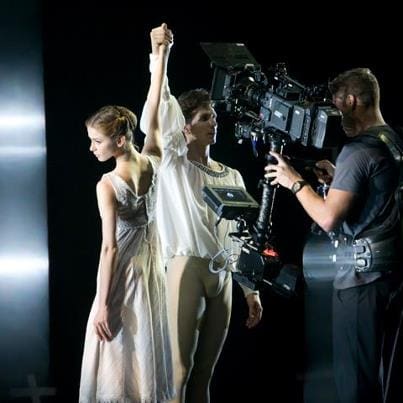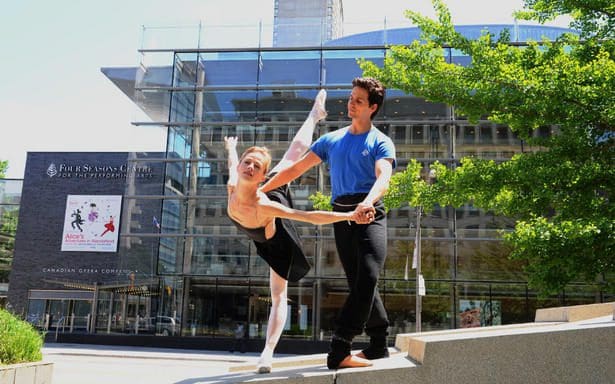 The National Ballet of Canada is a fascinating place. It’s where national treasures like Karen Kain and Rex Harrington earned their world-renowned reputations and are now guiding the current wave of tremendous talent as Artistic Director and Artist-in-Residence. It’s home to some of Toronto’s most beloved performers, some of the world’s most talented dancers and a world premiere or two. By the time a National Ballet production hits the Four Seasons Centre stage, it’s so beautifully polished that the critical eye has to strain to see any flaws in the company’s performance. The ballet is one of the few remaining artistic institutions that is treated with great reverence, and glimpses behind the perfection are rare, but in those few moments when the curtain is pulled aside what really comes through is what a compelling company the National has assembled of dancers who do so much more than dance.
The National Ballet of Canada is a fascinating place. It’s where national treasures like Karen Kain and Rex Harrington earned their world-renowned reputations and are now guiding the current wave of tremendous talent as Artistic Director and Artist-in-Residence. It’s home to some of Toronto’s most beloved performers, some of the world’s most talented dancers and a world premiere or two. By the time a National Ballet production hits the Four Seasons Centre stage, it’s so beautifully polished that the critical eye has to strain to see any flaws in the company’s performance. The ballet is one of the few remaining artistic institutions that is treated with great reverence, and glimpses behind the perfection are rare, but in those few moments when the curtain is pulled aside what really comes through is what a compelling company the National has assembled of dancers who do so much more than dance.
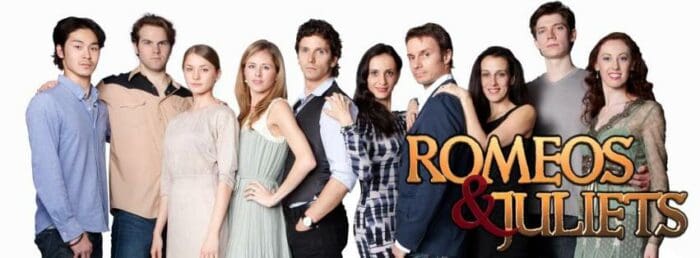
It’s easy to show up at the ballet, watch the pretty pirouettes, have a drink at intermission, admire some impressive lifts and go home without much thought to who it was pirouetting and being lifted. But the more you see of The National Ballet of Canada, the more you start to appreciate the differences between principal dancers, making the experience a hundred times more interesting. Take Onegin, for instance. The first time I saw it, Jiri Jelinek was dancing the aloof title role with Guillaume Cote as his friend Lensky. Cote almost never dances a supporting role-he’s the company’s most popular leading man- but he has a romanticism to his dancing, he’s sweet and likable and therefore the perfect Lensky, whereas Jelinek is harder, most forceful, and was at the time a stranger to Toronto audiences. The casting also meant that Cote was paired with his then-fiancee-now-wife Heather Ogden as Olga, meaning that Onegin‘s sweetest and most loving couple was more than convincing.
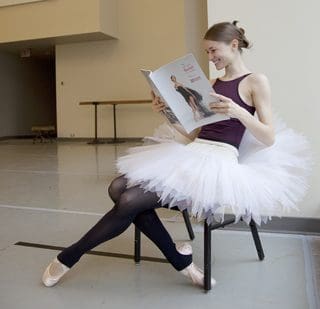
When the casting comes out for any given National Ballet production, I look at the partnerings, the type of role each dancer’s been given, and the nights they’ve been assigned to perform it (technically the opening night cast is supposed to be “the best”, but I don’t always agree). The National Ballet dancers all have such unique styles and on-stage personalities that it really informs the piece. And the more attention you pay, the more interesting they get as off-stage people too. For example, take a look at most promotional and production photos of the current company and the credit will say “photo by Aleksander Antonijevic”. Antonijevic is a principal dancer celebrating 20 years with the company but is also a professional photographer (he had an exhibit in the lobby of the Four Seasons Centre during the runs of Hamlet and Chroma). Guillaume Cote is a composer and choreographer (nominated for a Dora Award this year) who has gotten his inspiration from, among others, paintings by fellow dancer Zdenek Konvalina. The National Ballet is also home to more love stories than most companies put together (Cote-Ogden, Lavigne-Hodgkinson, Konvalina-Zehr, to name a few). The National Ballet dancers are fascinating, awesome, intriguing people and that, more than backstage voyeurism or choreographic curiosity, was what made the allure of the CBC documentary Romeos & Juliets so strong.
Romeos & Juliets
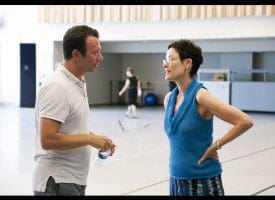 When Karen Kain announced that the company would be premiering a new version of Romeo & Juliet choreographed by Alexei Ratmansky, I was skeptical about replacing the sensational Cranko version in the company rep. The result was pretty enough (and returning to the stage in the 12/13 season) but not nearly as compelling as the behind-the-scenes stories told in the CBC documentary about its creation. Through backstage video and interviews, director Moze Mossanen takes viewers through casting, final rehearsals and opening night of Romeo & Juliet. At one hour (with commercials), the doc is way too short and thus skims over a lot, but it’s otherwise expertly executed. As the most famous ballet dancer in Canadian history and a character actor in Romeo & Juliet (he played the prince), Rex Harrington forms the voice of the documentary with extensive interviews. I would have preferred more from Kain, Ratmansky or, even better, the actual dancers, but you won’t find many people complaining about too much Rex Harrington (and hearing him talk about what it takes to form a great partnership is really sweet when intercut with shots of his famous dance partner Karen Kain).
When Karen Kain announced that the company would be premiering a new version of Romeo & Juliet choreographed by Alexei Ratmansky, I was skeptical about replacing the sensational Cranko version in the company rep. The result was pretty enough (and returning to the stage in the 12/13 season) but not nearly as compelling as the behind-the-scenes stories told in the CBC documentary about its creation. Through backstage video and interviews, director Moze Mossanen takes viewers through casting, final rehearsals and opening night of Romeo & Juliet. At one hour (with commercials), the doc is way too short and thus skims over a lot, but it’s otherwise expertly executed. As the most famous ballet dancer in Canadian history and a character actor in Romeo & Juliet (he played the prince), Rex Harrington forms the voice of the documentary with extensive interviews. I would have preferred more from Kain, Ratmansky or, even better, the actual dancers, but you won’t find many people complaining about too much Rex Harrington (and hearing him talk about what it takes to form a great partnership is really sweet when intercut with shots of his famous dance partner Karen Kain).
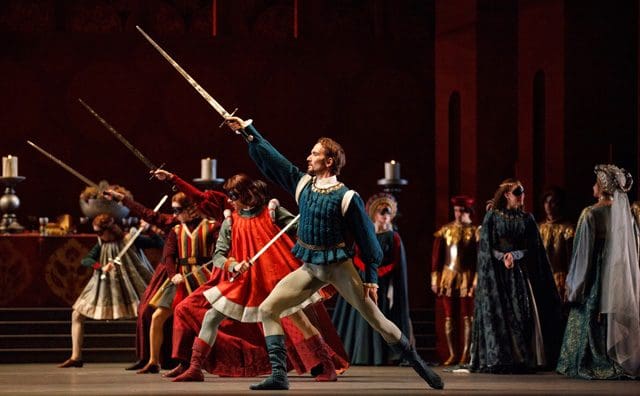 Since the doc jumps in just weeks before opening night, it’s not a creation story so much as a casting/rehearsal story. As much as I would have loved more of a glimpse into Ratmansky’s mind while choreographing, the focus on the dancers is great. There are 5 pairings for the title roles and (other than a small, interesting subplot about the second soloist/corps de ballet duo who fight their way back in after being cut from the show) all the focus is on the opening night coupling of Guillaume Cote and first soloist Elena Lobsanova. As an obnoxious R&J nerd, I would have appreciated more on Jiri Jelinek’s fierce Tybalt or the development of the piece’s standout character, Mercutio (played beautifully by the great Jonathan Renna the night I saw the production), but with such a short documentary there wasn’t much room to explore anything other than the premiere cast title roles. Luckily, the out-of-the-box casting of Juliet meant that there was lots to explore even with such a small focus. Cote was an obvious and easy choice for Romeo for all the reasons previously mentioned and because he is, as the documentary calls him, “a darling of the audience” (and if 42-year-old Aleksander Antonijevic can still play Romeo, 30-year-old Cote certainly can). But, by that logic, Heather Ogden was the obvious and easy choice for Juliet. Instead, Ogden led the second cast alongside McGee Maddox while Lobsanova was controversially elevated to star on opening night with Cote despite only being a first soloist, not a principal.
Since the doc jumps in just weeks before opening night, it’s not a creation story so much as a casting/rehearsal story. As much as I would have loved more of a glimpse into Ratmansky’s mind while choreographing, the focus on the dancers is great. There are 5 pairings for the title roles and (other than a small, interesting subplot about the second soloist/corps de ballet duo who fight their way back in after being cut from the show) all the focus is on the opening night coupling of Guillaume Cote and first soloist Elena Lobsanova. As an obnoxious R&J nerd, I would have appreciated more on Jiri Jelinek’s fierce Tybalt or the development of the piece’s standout character, Mercutio (played beautifully by the great Jonathan Renna the night I saw the production), but with such a short documentary there wasn’t much room to explore anything other than the premiere cast title roles. Luckily, the out-of-the-box casting of Juliet meant that there was lots to explore even with such a small focus. Cote was an obvious and easy choice for Romeo for all the reasons previously mentioned and because he is, as the documentary calls him, “a darling of the audience” (and if 42-year-old Aleksander Antonijevic can still play Romeo, 30-year-old Cote certainly can). But, by that logic, Heather Ogden was the obvious and easy choice for Juliet. Instead, Ogden led the second cast alongside McGee Maddox while Lobsanova was controversially elevated to star on opening night with Cote despite only being a first soloist, not a principal.
That gutsy choice by Ratmansky leads to the documentary’s most compelling drama. As an audience member who didn’t bet on Lobsanova’s success and bought a ticket to see Ogden instead, watching her nervous determination to prove people like me wrong was really endearing. It’s fascinating to see the rehearsal process and how partnerships form, particularly when Cote & Lobsanova are juxtaposed with the time-honoured pairing of Aleksander Antonijevic & Greta Hodgkinson. Cote, predictably, comes off as a prince as he mentors Lobsanova with superhuman patience, losing his cool incredibly rarely. And Lobsanova, still relatively unknown to Toronto audiences, proves to be the film’s most compelling character with her intense dedication, indomitable sweetness and unsure humility. Watching them struggle to anticipate each other like seasoned partners and Cote struggle with Lobsanova’s inexperience is incredibly humanizing and makes the somewhat boring production of Romeo & Juliet something I would love to see again. A particularly lovely sequence mashes up all five pairings as they dance the balcony scene, Cote making the point in voice-over that “that’s why ballet’s so cool! You can go five different times and see five completely different shows”. The opening night pair sitting on the Four Seasons Centre steps and reading their reviews feels incredibly staged, but that scene segues beautifully into the documentary’s last, the entire company back at the barre the next morning starting their day together with the ballet basics. I enjoyed the production okay, but Romeos & Juliets was what made me really interested in The National Ballet’s production of Romeo & Juliet. The CBC should do a similar documentary on each major production in The National’s season, but make it a series so there’s really room to delve.
Hamlet
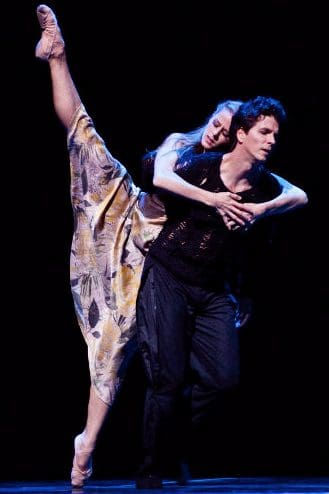 Days before I saw Romeos & Juliets, I took in the National Ballet’s other Shakespeare production this season, Kevin O’Day’s contemporary Hamlet. Since I just waxed poetic about Romeos & Juliets for many many paragraphs, I’ll keep this review relatively short*. In the surprise of the century, the main point I absolutely have to make is that Guillaume Cote was nothing short of mesmerizing in the title role on opening night. I know, I know, stop gushing, but he was the leading man of both things I’m discussing so a little gushing is in order. Cote is one of the most technically superb dancers in the technically superb company and he always seems lighter than air when performing. But Hamlet was the first time I really noticed his acting ability. The piece began with a silent soliloquy out on the stage left partial thrust. Sitting in the Orchestra Ring on far stage left, I was about a meter away from Cote and could see the honest anguish he was able to muster for what I assume was supposed to be the ballet’s equivalent of I.ii’s “oh that this too too solid flesh” soliloquy. From there on in, Cote was the heart and soul of the production (as Hamlet should be), in the best performance I’ve ever seen from him. Heather Ogden’s Ophelia was similarly beautiful and it was so so great to see them dance together again. The surprise of the production for me was McGee Maddox’s Laertes. I didn’t love Maddox’s Romeo because he’s just a little too hulking for most parts, a little too heavy-footed; he’s a very masculine dancer in a specifically young way. But that sometimes-limiting vibe was actually perfect casting for Laertes, who has to be similar in age and upbringing to Hamlet but contrasting in demeanour. Maddox brought a demeanour of control that Laertes doesn’t always have but is very interesting, and I bought his dedication to Ophelia and his father (a repressed Jonathan Renna whom I’m sure was a much better Rosencrantz than Polonius since he’s one of the funniest members of the company and this was the least funny Polonius ever directed). On the other side of the coin, for the first time since he joined the company for the aforementioned Onegin, I wasn’t particularly impressed with Jiri Jelinek. He’s perfect casting for Claudius with his mach0-commmanding style but Jelinek wasn’t as precise as he generally has been, though some of that may have related to O’Day’s choreography, which characterized Claudius and his court as savages.
Days before I saw Romeos & Juliets, I took in the National Ballet’s other Shakespeare production this season, Kevin O’Day’s contemporary Hamlet. Since I just waxed poetic about Romeos & Juliets for many many paragraphs, I’ll keep this review relatively short*. In the surprise of the century, the main point I absolutely have to make is that Guillaume Cote was nothing short of mesmerizing in the title role on opening night. I know, I know, stop gushing, but he was the leading man of both things I’m discussing so a little gushing is in order. Cote is one of the most technically superb dancers in the technically superb company and he always seems lighter than air when performing. But Hamlet was the first time I really noticed his acting ability. The piece began with a silent soliloquy out on the stage left partial thrust. Sitting in the Orchestra Ring on far stage left, I was about a meter away from Cote and could see the honest anguish he was able to muster for what I assume was supposed to be the ballet’s equivalent of I.ii’s “oh that this too too solid flesh” soliloquy. From there on in, Cote was the heart and soul of the production (as Hamlet should be), in the best performance I’ve ever seen from him. Heather Ogden’s Ophelia was similarly beautiful and it was so so great to see them dance together again. The surprise of the production for me was McGee Maddox’s Laertes. I didn’t love Maddox’s Romeo because he’s just a little too hulking for most parts, a little too heavy-footed; he’s a very masculine dancer in a specifically young way. But that sometimes-limiting vibe was actually perfect casting for Laertes, who has to be similar in age and upbringing to Hamlet but contrasting in demeanour. Maddox brought a demeanour of control that Laertes doesn’t always have but is very interesting, and I bought his dedication to Ophelia and his father (a repressed Jonathan Renna whom I’m sure was a much better Rosencrantz than Polonius since he’s one of the funniest members of the company and this was the least funny Polonius ever directed). On the other side of the coin, for the first time since he joined the company for the aforementioned Onegin, I wasn’t particularly impressed with Jiri Jelinek. He’s perfect casting for Claudius with his mach0-commmanding style but Jelinek wasn’t as precise as he generally has been, though some of that may have related to O’Day’s choreography, which characterized Claudius and his court as savages.
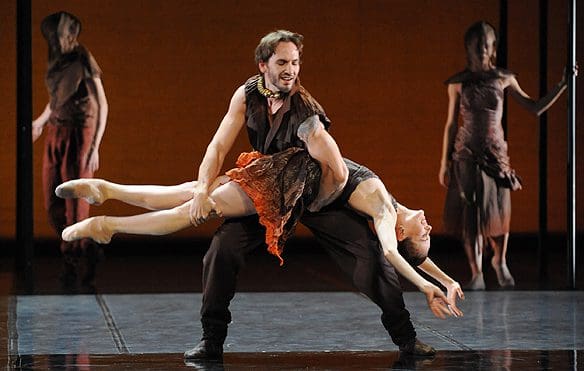 When it comes down to it, I wasn’t actually all that impressed with the piece itself- the choreography, John King’s dystopic music, Tatyana van Walsum’s design. For starters, the storytelling takes some foolish liberties with Shakespeare’s text, to the point where I’m sure it would be hard to follow if you don’t know the play particularly well. (Just as a very very basic note, you cannot cut the ghost from Hamlet– it’s uncompromisingly central to the play’s plot and the title character’s mental state. You probably also shouldn’t cut the entire England trip, Fortinbras and the antic disposition, but those things are less crucial). I enjoyed Kevin D Bowles’ amusing take on the Gravedigger but it was a strong example of the drawn-out quality of the whole piece. Hamlet is not an action story. In fact, its very essence is about inaction, so if you take the words away, dancers are left with very little story to actually tell (it might make a good one act, but it doesn’t have a full two-hour plot). Hamlet is about words and the differences between what we think and what we do (although if you cut the ghost and the antic disposition and dramatically edit the Players, I suppose those themes are arguable), the medium of ballet I don’t think has the capacity to really present that (dance elevates the story of Romeo & Juliet, it takes something away from Hamlet). Especially if complicating characters like Claudius are simplified down to savages, all that’s really left of Hamlet is Hamlet’s mental anguish, which, despite Cote’s best efforts, presents itself mostly through thrashing and a stylistic but court-inappropriate torn tunic. There were elements of greatness in Hamlet (mostly in Hamlet himself) but the production as a whole didn’t make sense in either theory or dark, savage execution.
When it comes down to it, I wasn’t actually all that impressed with the piece itself- the choreography, John King’s dystopic music, Tatyana van Walsum’s design. For starters, the storytelling takes some foolish liberties with Shakespeare’s text, to the point where I’m sure it would be hard to follow if you don’t know the play particularly well. (Just as a very very basic note, you cannot cut the ghost from Hamlet– it’s uncompromisingly central to the play’s plot and the title character’s mental state. You probably also shouldn’t cut the entire England trip, Fortinbras and the antic disposition, but those things are less crucial). I enjoyed Kevin D Bowles’ amusing take on the Gravedigger but it was a strong example of the drawn-out quality of the whole piece. Hamlet is not an action story. In fact, its very essence is about inaction, so if you take the words away, dancers are left with very little story to actually tell (it might make a good one act, but it doesn’t have a full two-hour plot). Hamlet is about words and the differences between what we think and what we do (although if you cut the ghost and the antic disposition and dramatically edit the Players, I suppose those themes are arguable), the medium of ballet I don’t think has the capacity to really present that (dance elevates the story of Romeo & Juliet, it takes something away from Hamlet). Especially if complicating characters like Claudius are simplified down to savages, all that’s really left of Hamlet is Hamlet’s mental anguish, which, despite Cote’s best efforts, presents itself mostly through thrashing and a stylistic but court-inappropriate torn tunic. There were elements of greatness in Hamlet (mostly in Hamlet himself) but the production as a whole didn’t make sense in either theory or dark, savage execution.
The best things about The National Ballet of Canada’s production of Hamlet? These two promotional videos. They each feature one of the company’s superb Hamlets and a great of Canadian classical theatre. Not to be missed by either a Shakespeare or Ballet fan.
Albert Schultz on Hamlet, Piotr Stanczyk dances the role in rehearsal
Colm Feore performs “To Be or Not to Be”, Guillaume Cote in rehearsal
*points to anyone who spots the accidental Polonius joke in the juxtaposition of that statement and the eventual length of the review.

